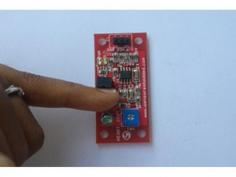
Heart Beat Sensor
The heart beat sensor functions by providing a digital display of pulse readings. As the heart beat detector operates, the LED on the sensor will flash in correlation with each beat of the heart. This digital signal can be linked directly to a microcontroller for accurate measurement of the heart’s Beats Per Minute (BPM) rate. Its operation is based on the modulation of light caused by blood flow through the finger during each pulse.
Some notable characteristics of Heart beat Sensor include:
The LED displays your heart rate.
To quickly have a digital output signal that can be directly connected to a microcontroller
Small and easy to carry design.
The voltage required for operation is 5V DC.
Steps to Establish a Connection:
The heart beat sensor is initially supplied with 5V of power.
When the forefinger is placed over the sensor, the LED flashes continuously in response to heart pulses.
The output pin can be linked to any of the microcontroller’s I/O pins for displaying the heart rate in BPM.
There are a variety of different uses for this product, such as in industries, businesses, and personal settings.
A monitor is essential today to many health-conscious people who want to track their heart rate.
In today’s world, staying in tune with one’s heart rate is highly valued among those who prioritize their health. As a result, a digital heart rate monitor has become a staple device for many individuals.
The patient monitoring system is a crucial tool for tracking the health of our patients. This system allows us to closely monitor any changes or progress in their condition, ensuring that we can provide the best possible care.
The implementation of bio-feedback control in robotics and its practical uses.

